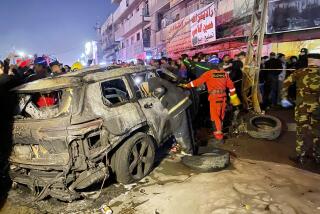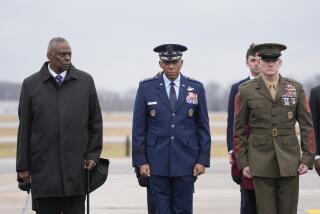White House to finally reveal civilian deaths from U.S. drone attacks
Not long after a U.S. drone strike killed his brother-in-law and a nephew in a village in central Yemen, Faisal bin Ali Jaber received a phone call from a Yemeni government official.
The man invited the engineer to Sana, the nation’s capital, to discuss why a drone had targeted and killed five men meeting under a palm tree in Khashamir after dark on Aug. 29, 2012.
Jaber appeared at the government building, but he was given no explanation or apology. Instead he was handed a plastic bag with $100,000 in sequentially marked $100 bills, a relative fortune in the Arab world’s poorest country, he said.
“They told me, ‘We are not authorized to tell you where this money came from, but take it,’” Jaber, 58, said via an Arabic interpreter in a phone interview from Montreal, where he now lives. “I knew it must be the American government, so I wondered: ‘Why they would do this? Why would they pay this blood money in secret?’”
President Obama is expected to disclose as early as Friday that U.S. military and CIA drone strikes inadvertently have killed about 100 civilians since 2009 in countries where the United States is not officially at war, according to U.S. officials who were not authorized to speak publicly.
The long-awaited report focuses on the so-called shadow wars in Yemen, Pakistan, Libya and Somalia and only during Obama’s tenure. It covers about 500 drone attacks in all.
The tally does not include civilian casualties for Iraq, Syria and Afghanistan, where U.S. forces have launched thousands of air attacks as part of ongoing wars and where the Pentagon formally investigates allegations of civilian deaths.
Obama plans to issue an executive order that would call on his successor to annually disclose the number of civilians killed in drone strikes, officials said, a goal he announced in 2013 but met only in his last year in office.
He also is expected to disclose parts of the classified legal framework behind the drone program. Known as the Presidential Policy Guidance, it sets legal standards for deciding whom to kill, where and under what circumstances.
“It has been a long road to get this information out there,” one U.S. official said. “There have been concerns from nearly every agency within the government on what to reveal and fears about revealing too much.”
The official tally is far lower than the death toll claimed by human rights organizations and other independent groups that monitor America’s growing use of combat drones. Their estimates range from 200 to more than 1,000.
“The White House’s accounting of civilian casualties is unlikely to be worth the paper it’s printed on,” said Jennifer Gibson, an attorney at Reprieve, a human rights and advocacy group based in London. The group says local news reports, interviews and other sources suggest drones have killed at least 1,147 civilians.
“We need real transparency from this president — not just numbers, but the definition of who counts as a civilian, the rules for taking such strikes and the procedures for investigating mistakes afterwards,” Gibson said.
Obama promised greater transparency and oversight on drone strikes in a May 2013 speech at National Defense University. It marked a shift for Obama, who had vastly expanded the targeted-killing program begun by his predecessor, George W. Bush.
“Unless we discipline our thinking and our actions, we may be drawn into more wars we don’t need to fight, or continue to grant presidents unbound powers more suited for traditional armed conflicts between nation states,” he said at the time.
Until now, the administration has provided few details of how the drone program is structured, what legal restrictions apply, and what oversight or accountability is involved. The Pentagon has only acknowledged a handful of civilian deaths.
Officials argue that combat drones, which typically are piloted from Creech Air Force Base in Nevada, allow policymakers a way to target terrorists or other potential enemies without involving U.S. ground troops.
They say drones are less likely to cause civilian casualties than manned aircraft, because they can watch a potential target for months before a missile is launched.
The CIA, the Air Force and Pentagon’s Joint Special Operations Command fly combat drones. All are required to assess potential civilian casualties before firing a missile, with a sliding scale of what is permitted, officials said.
The U.S. will accept the risk of several civilian casualties when attacking a senior militant leader, for example, but a single civilian death could be considered excessive if the militant killed poses no threat.
The varying numbers, called the Non-Combatant Casualty Cut-Off Value, are secret and are approved by the president or the Defense secretary.
The military and CIA use software simulation programs to project the likelihood of causing innocent deaths. These simulations are then added to a computer-generated map to predict whether a missile blast could hurl fiery debris into a home or onto a roof.
Yet the limits of U.S. intelligence and remote-controlled air attacks have been visible for years. At least eight Americans have been killed by drone attacks, for example, but only one — Anwar Awlaki, an Al Qaeda leader in Yemen — was specifically targeted.
In April 2015, for example, Obama announced that a CIA drone strike that January on an Al Qaeda compound in northwest Pakistan had mistakenly killed two foreign hostages, including Warren Weinstein, a 73-year-old American aid worker who had been held for four years.
Hundreds of hours of aerial surveillance, communications intercepts and other intelligence had failed to spot signs of the hostages, officials said.
T. Mark McCurley, a retired drone pilot who commanded an MQ-1 Predator squadron, said releasing civilian casualty numbers is not “necessarily a good choice,” considering “there is no standard methodology for counting the dead.”
Until recently, the Obama administration admitted only a handful of civilian deaths because officials counted any military-age male killed as combatants unless evidence showed they were not after the fact, according to former military and intelligence officials.
The White House is not expected to release names, geographic locations or dates of civilians killed. It thus will be difficult to check the government’s data against that collected by independent groups.
Those figures vary widely. The British-based Bureau of Investigative Journalism, for example, estimates up to 1,068 civilians were killed in Pakistan, Yemen and Somalia. The New American Foundation, a nonprofit think tank in Washington, says as many as 294 civilians have been killed in those countries.
Most of those killed die in relative anonymity. After the 2012 airstrike in Yemen, however, Reprieve, the British-based group, helped Jaber, the engineer given $100,000, sue the U.S. government for wrongful death.
The lawsuit, filed in U.S. District Court in Washington, was dismissed this year. Jaber is appealing.
Jaber said he thinks his brother-in-law, Salem, a Muslim imam, and his nephew, Waleed, a police officer, were mistakenly targeted as members of Al Qaeda.
Jaber said Salem had given a sermon in Khashamir to denounce Al Qaeda’s ideology. Days later, he met several men who came to the village and brought Waleed in case anything went wrong.
Four missiles exploded as the five men talked under a palm tree at about 9 p.m., killing them all. Jaber believes the visitors were Al Qaeda members, and his family was collateral damage.
“What happened in the past can’t be changed. Families know innocent people have been killed,” Jaber said. “The American government says it will provide transparency into the drone program. The fact is innocent people don’t want to die, whether or not the government provides transparency.”
ALSO
10 killed in 2 explosions at Istanbul airport, officials say
Clinton on Benghazi report: ‘I think it’s pretty clear that it’s time to move on’
More to Read
Start your day right
Sign up for Essential California for news, features and recommendations from the L.A. Times and beyond in your inbox six days a week.
You may occasionally receive promotional content from the Los Angeles Times.







